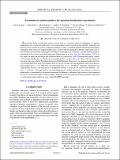Astronomical random numbers for quantum foundations experiments
Author(s)
Leung, Calvin; Brown, Amy; Nguyen, Hien; Friedman, Andrew S.; Gallicchio, Jason; Kaiser, David I.; ... Show more Show less
DownloadPhysRevA.97.042120.pdf (1.517Mb)
PUBLISHER_CC
Publisher with Creative Commons License
Creative Commons Attribution
Terms of use
Metadata
Show full item recordAbstract
Photons from distant astronomical sources can be used as a classical source of randomness to improve fundamental tests of quantum nonlocality, wave-particle duality, and local realism through Bell's inequality and delayed-choice quantum eraser tests inspired by Wheeler's cosmic-scale Mach-Zehnder interferometer gedanken experiment. Such sources of random numbers may also be useful for information-theoretic applications such as key distribution for quantum cryptography. Building on the design of an astronomical random number generator developed for the recent cosmic Bell experiment [Handsteiner et al. Phys. Rev. Lett. 118, 060401 (2017)PRLTAO0031-900710.1103/PhysRevLett.118.060401], in this paper we report on the design and characterization of a device that, with 20-nanosecond latency, outputs a bit based on whether the wavelength of an incoming photon is greater than or less than ≈700 nm. Using the one-meter telescope at the Jet Propulsion Laboratory Table Mountain Observatory, we generated random bits from astronomical photons in both color channels from 50 stars of varying color and magnitude, and from 12 quasars with redshifts up to z=3.9. With stars, we achieved bit rates of ∼1×10⁶Hz/m², limited by saturation of our single-photon detectors, and with quasars of magnitudes between 12.9 and 16, we achieved rates between ∼10² and 2×10³Hz/m². For bright quasars, the resulting bitstreams exhibit sufficiently low amounts of statistical predictability as quantified by the mutual information. In addition, a sufficiently high fraction of bits generated are of true astronomical origin in order to address both the locality and freedom-of-choice loopholes when used to set the measurement settings in a test of the Bell-CHSH inequality.
Date issued
2018-04Department
Massachusetts Institute of Technology. Department of Physics; Massachusetts Institute of Technology. Program in History, Anthropology, and Science, Technology, and SocietyJournal
Physical Review A
Publisher
American Physical Society
Citation
Leung, Calvin et al. "Astronomical random numbers for quantum foundations experiments." Physical Review A 97, 4 (April 2018): 042120
Version: Final published version
ISSN
2469-9926
2469-9934